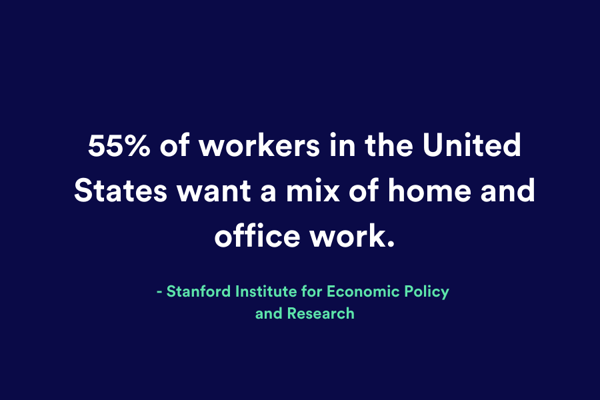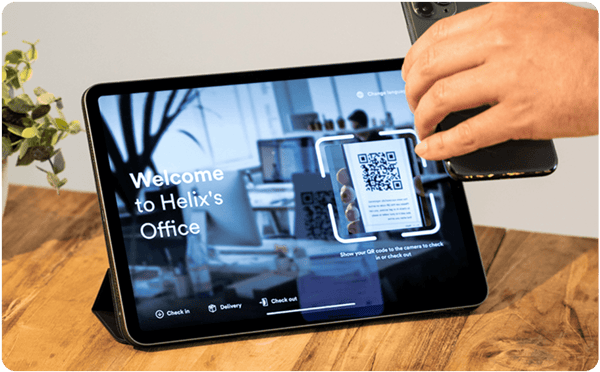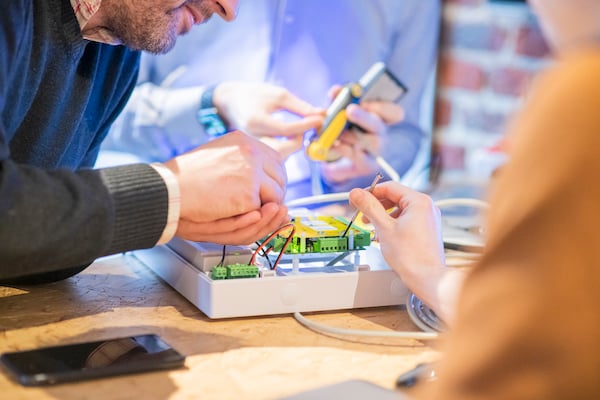Inside the new workplace: 4 reasons the office remains in-demand

This year has drastically impacted businesses all around the world, in many cases ramping up the adoption of new and innovative technology.
According to a recent McKinsey survey of 800 senior executives, 85% of companies have accelerated digitization. This includes supply chains, customer channels, and employee interaction and collaboration.
And while some of us thrived - and some of us merely survived - working from home, workers are demanding a hybrid or flexible working arrangement as offices reopen around the world.
It is clear that we’re unlikely to go back to the way things were.
It’s a hybrid working world
Let’s face it: working remotely has its disadvantages.
It has been a significant challenge for many employers to foster and maintain the same communication standards and workplace culture, virtually. Despite many organizations trying to minimize the impact of these unprecedented challenges on their productivity, results, and above all, on employees.
Hybrid working arrangements could solve some of these problems. A survey from earlier this year showed that 55% of workers in the United States want a mix of home and office work. While in the UK, employers are gearing up for a bigger remote workforce with 37% employees working from home in the post-pandemic world, compared to only 18% from before.

"I think all companies across the board are looking at remote or hybrid [working arrangements]. [We need to ask], ‘what can we do as a company to give them resources and flexibility?’ We’re seeing so much evolution around giving employees flexibility that works with their schedules." - Lisa Peterson, Facilities Services Manager, Columbia Sportswear Co.
All in all, people are ready to come to the workplace in some capacity, and it is unlikely that businesses will want to sustain a completely remote culture. That’s because there are tangible benefits to the in-person connections and collaborations brought about by sharing a workplace.
Key priorities for the new, safer workplace
Whether businesses choose to keep their offices, downsize or rent flexible workspaces, there'll be a bigger focus on employee wellbeing. That is, getting employees, visitors, contractors, customers, and all people into buildings safely while ensuring workers have all the resources they need to stay productive (and to socialize).
Workplace technologies to propel us forward
Technologies - and further digitalization of the workplace - will be crucial to meeting these requirements. To minimize health risks and abide by local and national guidelines on pandemic control, employers will be aided by tech solutions including:
- Pre-entry wellness checks that ask key questions and check the temperatures of employees and visitors at the entrance or lobby
- Visitor management solutions to keep track of employees, visitors, contractors, and all people flows within the office
- Autonomous cleaning solutions that make shared bathrooms cleaner and safer
- Low-touch and voice-enabled tech in key places like the kitchen for better hygiene
- Employee wellness, communication, and engagement tools for an on-the-go HR that is just as effective when working remotely
- Touchless entry and air filtration in buildings and elevators
- Social distancing sensors in common areas as well as desk spaces
- Remote collaboration tools that make remote and in-person conferences more productive

New and existing cutting-edge technologies are making it easier than ever for companies to adapt to a new normal.
All in all, businesses will also have to make these key investments in employee wellness, HR tools for better accessibility, remote collaboration tools, and cybersecurity technology. Next on their agendas will be to create workforce training programs that enhance professional development and teach staff how to use these new technologies more efficiently.
4 reasons why the office will remain alive
We can’t predict exactly what the buildings will look like in the next few years, but we are confident that offices will remain a permanent fixture in our lives.
Businesses around the world are now thinking longer term, and coming up with alternative ways to structure communication, working hours, and the need for employees to be physically present.
There is no doubt that combining in-office work with remote work is the way to go. This simply means that the office isn’t dead - it never was. Here are some more reasons why the office is and will always be alive:
1. It’s great for mental health
Social interaction is an essential element of the work environment, and its importance cannot be overlooked.
It’s nice to go out for lunch with colleagues and interact with your team members (at a safe distance) around the coffee machine. A good office environment gives us ample social opportunities and lets us create a space between your private and work time. The Buffer State of Remote Work 2018 Report revealed this is the primary concern and challenge for the remote workers.
"You have to understand the employee, you have to understand the ‘why’ when they come back to the office. It’s not to sit at a desk and look at paperwork or a computer all day. It’s to engage and socialize - those are the interactions that we humans need and are missing." - Doug Lowrie, Workplace Experience Director of Wx, Sodexo
2. Training and development are better in-person
Although there are ample online resources available to help onboard and train employees, these methods don't work for everybody. Many people still prefer the in-person approach.
Interestingly, the office work environment helps employees acquire and develop new skills in a comfortable setting. It fosters a growth culture in the company and also boosts employee's confidence.

3. Fewer home office distractions
From pets to kids, to the laundry piling up and that one neighbor who always shows up when they aren’t supposed to, there’s a lot going on at home to hamper productivity. When you live where you work, it can be challenging to manage these two worlds separately.
However, in an office environment, there's clear separation.
A workplace eliminates such disruptions and makes it easier for you to manage and focus on the tasks.
4. It gives us a choice when in hybrid work environments
The office - or a flexible workplace - provides a nice balance to home working as employees are demanding hybrid working situations. The ability to change up environments helps us get a change of perspective for increased productivity, get the healthy distance we need from loved ones, build stronger relationships with colleagues, and collaborate face-to-face - all while keeping our freedom of flexibility in how and where we work.
"We've talked for a long time about giving people options and choices in the workplace. Now is our opportunity to expand that beyond the workplace into the community and beyond. And so it's just an evolution of neighborhood-based choice or activity-based working. There is no one solution that is right for everybody. And what we need to do is empower people to make the right choices for that."- Kay Sargent, Senior Principal - Director of WorkPlace, HOK
The new workplace calls for HR to lead the charge
In order for HR leaders to ensure safe, healthy, and happy offices and workplaces, they must take into account employees' home lives, mindsets, and personal characteristics.
As we continue to include the office as a workplace option, it will be important for HR teams to prioritize the following.
- Committing to new employee safety guidelines: It is imperative that businesses foster a transparent, action-oriented, and empathetic culture that promotes healthy relationships among employees, particularly in the context of this pandemic. It is also essential to reassess the policies, performance management, and communicate it to employees.
- Rethinking work: The heightened importance of safety can’t be overlooked, but it is also essential to identify and prioritize activities critical to business operations. It will help the employees with the transition to recovery.
- Reimagining the workplace: It's important to leverage technology in
meaningful ways to streamline the business processes and ensure a safe and secure working environment. These initiatives can benefit the company in the recovery phase and help the employees adjust to the post-COVID-19 workplace.
"We want to continue listening and continue the dialogue, and I think [these increased dialogues with employees] are really going to be seen as big priorities that the leadership team will look to HR to lead. And the HR team has an opportunity to really step up and play a strong role here." - Barry Marshall, Founding Partner, P5 Collaborative Consulting
A final takeaway
We’ve established that despite the presence and active acceptance of the remote working paradigm, the office isn't dead; it is evolving and here to stay.
As employers continue to navigate the complexities of reopening the workplace, businesses are increasingly concerned about how to maintain people flow management on the premises effectively.
The right cloud-based solution that tracks and screens everyone on-site (while keeping sensitive data private) is a must-have that can instill confidence around worker safety and security.
See Proxyclick's latest features for managing flows of employees, visitors, and contractors across your locations.



